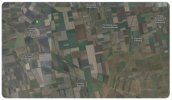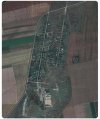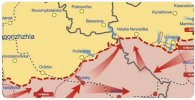Antares
Respected Leader
Venäläisen Telegram-bloggaajan kirjoitus eteläisen Ukrainan taistelualueesta, mitä haasteita se tuo molemmille:
The Russian Telegram blogger Vladlen Tartarsky has written a useful description of the terrain in occupied southern Ukraine, which helps to highlight the difficulties that both sides are facing in fighting over it. Translation follows.

"From Kherson and practically to Donetsk, the terrain is flat fields, sometimes riddled with gullies and small rivulets. The fields are divided by "zelenki", narrow flat plantations of deciduous trees and shrubs.
In the middle of the fields are small villages with 2-3 streets, usually with a farm and a school. To the north of Donetsk, there are agglomerations and villages, sometimes moving from one to the other.

To the south and north of the Siverskiyi Donets [river] is a small strip of forest, then again fields. Despite the fact that probably 90% of military ranges are fields, it is combat operations in these conditions that present the greatest difficulty.
Concentrations of equipment are easily detected by UAVs and if the artillerymen are well trained, even an attempt to reach the attack line will end badly.
[Ukraine] has created a solid minefield along the line from the Dnipro [river] to Marinka, which also makes it very difficult to use armoured vehicles.

Attempts to occupy strongholds without armour support, in small groups that try to approach the enemy stealthily, ninja-party style, also often end miserably, mainly due to enemy artillery that cannot be suppressed.
Attacking without suppressing artillery is a great sin, this has been known since World War I, but for some reason this commandment has been forgotten [by Russia].
After all, it doesn't matter how many men are advancing on a stronghold, 10 or 100 – shells will cope with any number.
In order to suppress enemy artillery you need more modern artillery radars or UAVs capable of hovering behind enemy lines (if they were kamikaze drones, there would be no problem at all), and high-precision munitions.
The asymmetrical way of counterbattery warfare – destroying supply depots, logistics centres and bridges ... significantly reduces the enemy's artillery potential, but does not solve the problem completely. There is a need for comprehensive work here."
Source:
https://t.me/vladlentatarsky/16845

"From Kherson and practically to Donetsk, the terrain is flat fields, sometimes riddled with gullies and small rivulets. The fields are divided by "zelenki", narrow flat plantations of deciduous trees and shrubs.
In the middle of the fields are small villages with 2-3 streets, usually with a farm and a school. To the north of Donetsk, there are agglomerations and villages, sometimes moving from one to the other.

To the south and north of the Siverskiyi Donets [river] is a small strip of forest, then again fields. Despite the fact that probably 90% of military ranges are fields, it is combat operations in these conditions that present the greatest difficulty.
Concentrations of equipment are easily detected by UAVs and if the artillerymen are well trained, even an attempt to reach the attack line will end badly.
[Ukraine] has created a solid minefield along the line from the Dnipro [river] to Marinka, which also makes it very difficult to use armoured vehicles.

Attempts to occupy strongholds without armour support, in small groups that try to approach the enemy stealthily, ninja-party style, also often end miserably, mainly due to enemy artillery that cannot be suppressed.
Attacking without suppressing artillery is a great sin, this has been known since World War I, but for some reason this commandment has been forgotten [by Russia].
After all, it doesn't matter how many men are advancing on a stronghold, 10 or 100 – shells will cope with any number.
In order to suppress enemy artillery you need more modern artillery radars or UAVs capable of hovering behind enemy lines (if they were kamikaze drones, there would be no problem at all), and high-precision munitions.
The asymmetrical way of counterbattery warfare – destroying supply depots, logistics centres and bridges ... significantly reduces the enemy's artillery potential, but does not solve the problem completely. There is a need for comprehensive work here."
Source:
https://t.me/vladlentatarsky/16845


